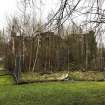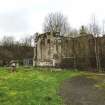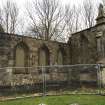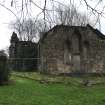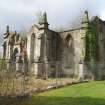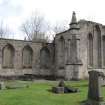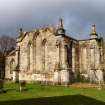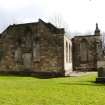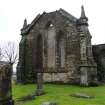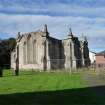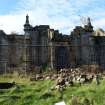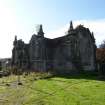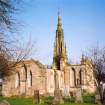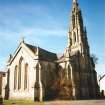Notice
Following a review of the Buildings at Risk Register we have paused the Register while we consider options for its future.
The website will remain accessible and searchable during this time, but it will not be updated and we’re not accepting nominations for additions to the Register. If you need to contact us about the BARR please email hmenquiries@hes.scot
Read the review report here and you can find out more about why we have paused the BARR on our news centre.
Millburn Free Church, Main Street, Renton
Ordnance Survey licence number AC0000807262. All rights reserved. © Copyright and database right 2025. Public Sector Viewing Terms
Useful Links
- Canmore:
- RENTON, MAIN STREET, MILLBURN CHURCH
- Historic Scotland:
- HS Reference No 1176
General Details and Location
Category
AT RISK
Name of Building
Millburn Free Church
Other Name(s)
Address
Main Street, Renton
Locality
Postcode
Planning Authority
Divisional Area
Reference No
1959
Listing Category
A
OS Grid Ref
NS 38792 78916
Location Type
Urban
HS Reference No
1176
Description
Cruciform-plan gothic church, miniature Early English with late gothic central entrance tower. Ashlar fronted; squared and snecked rear and side elevation; ashlar, margins and dressings. Lancets; eaves course; base course; angle buttresses; squat pyramidal pinnacles.
The building is no longer in ecclesiastical use. It was built as the Free Church. It is now in a poor state of repair with the interior gutted, dampness and stone damage. Rochead designed the St John's Free Church, 205 George Street, Glasgow 1845 which boasts a similar spire of tiered pinnacles and its seems probable that he designed this sibling Free Church at the same time. Millburn Church had previously been attributed tentatively to George Meikle Kemp, an architect familiar with such Gothic work (see the Scott Monument) who had been working reputedly at Millburn Tower. However, this attribution now seems unlikely in view of the Rochead parallel. (Historic Scotland)
The building is no longer in ecclesiastical use. It was built as the Free Church. It is now in a poor state of repair with the interior gutted, dampness and stone damage. Rochead designed the St John's Free Church, 205 George Street, Glasgow 1845 which boasts a similar spire of tiered pinnacles and its seems probable that he designed this sibling Free Church at the same time. Millburn Church had previously been attributed tentatively to George Meikle Kemp, an architect familiar with such Gothic work (see the Scott Monument) who had been working reputedly at Millburn Tower. However, this attribution now seems unlikely in view of the Rochead parallel. (Historic Scotland)
Building Dates
1845
Architects
Probably John Thomas Rochead
Category of Risk and Development History
Condition
Ruinous
Category of Risk
Moderate
Exemptions to State of Risk
Field Visits
01/03/1997, 01/05/1998, 01/03/2003, 13/10/2008, 25/02/2011, 24/4/2013, 04/03/2020
Development History
25 January 1985: The Lennox Herald reports that the church has been reprieved from demolition after the Historic Buildings Branch of the Scottish Office noted that it should most probably be A-listed. Councillors are being urged to suspend demolition applications until the church's status is decided. 4 July 1985: The Evening Times reports that the church has now been A-listed, but that the Scottish Office is prepared to grant just 30% of the total repair costs, estimated at £100,000. Councillors were hopeful for 75%. Other press reports indicate that the Alexandria Christian Fellowship would be keen to move into the renovated building and use it as the centre for outreach activities. It is reported that the church entered the ownership of Dumbarton District Council after becoming surplus to Church requirements. February 1990: Inspection reveals the church now to be in a serious state of disrepair, with all internal fabric removed, including the floors, ceilings and wall coverings. 10 July 1991: The Dumbarton Reporter reports that the local Alcoholics Anonymous group has expressed interest in renovating the church. 20 December 1991: The Lennox Herald reports that the group's plans are still active, despite the church's renovation being costed at £100,000. Although Historic Scotland has indicated that much of the work would be eligible for grant aid, funds would probably not be available until 1993/1994. It has expressed concern at the ability of the AA group to supervise the work. Now local planners are advising that a marketing brief be produced in order to interest developers or housing associations. Marketing would run concurrent to negotiations with Alcoholics Anonymous. October 1994: SCT receives informaiton that Dumbarton District Council is in discussion with Cordale Housing Association over a proposal to convert the church into a childrens' day centre. September 1995: No change reported. May 1998: External inspection reveals the church's fabric to be in worsening condition, with the roof valleys collapsing. July 1998: The roof is now partly collapsed. Michael and Sue Thornley Architects, Glasgow have completed a feasibility study on options for the church. SCT understands that Renton Regeneration is establishing a trust to save the building and convert it into a museum on the turkey-red dye industry of the Vale of Leven. Support is currently being sought from Historic Scotland and the Heritage Lottery Fund. May 1999: The press carries notice of an application for the partial demolition of the roof. January 2002: Local planners are unaware of any change. 13 February 2003: The Clydebank Post and the Helensburgh Advertiser report on the church's inclusion on the Buildings at Risk Register. October 2003: Historic Scotland reports no change. 12 May 2004: The Dumbarton and Vale of Leven Reporter notes the building's inclusion in the Buildings at Risk Bulletin 2004-2005. December 2006: Lennox Herald reports that the steeple and frontage of the church has now collapsed.
March 2008: The Lennox reports on a campaign to restore the church. The article goes on to mention that Listed Building Consent is being prepared and will be submitted to Historic Scotland in due course.
October 2008: External inspection finds the church in a ruinous state. The upper sections of the chancel and trancepts have collapsed as well as the tower and entrance bay. The surviving masonry of the entrance bay appears to be extremely unstable.
November 2008: Local planners report that the condition of the surviving ruins is such that further (or indeed complete) demolition may be imminent, although as yet no application for listed building consent has been submitted.
January 2009: The Lennox Herald reports on local opposition to the demolition of the church. One campaigner proposes a cairn or monument to be considered as a replacement if the church is demolished.
April 2009: The Lennox Herald reports on local opposition to plans to demolish the church by West Dunbartonshire Council. The articles goes on to state that in reply to a campaigner‘s letter, Historic Scotland have advised that have recommended to the Council that the remains of the church are stabilised as a ruin within the burial ground. The application is reported to be sent to the planning cttee in due course.
January 2011: Historic Scotland report the former church remains a ruined shell. A local community group has put forward a monument/ cairn proposal to re-use masonry. Historic Scotland is seeking consolidation of the ruin.
February 2011: External inspection finds the building remains in much the same condition as on our previous visit.
March 2011: Dumbarton & Vale of leven Reporter notes that an application to demolish the building has been withdrawn.
24 April 2013: External inspection finds no significant change from the previous site visit.
4 March 2020: External inspection finds the building in a significant state of deterioration since last site visit. The church is secured by heras fencing. There is now a considerable amount of vegetation and tree growths, particularly obscuring the main façade of the church but also growing within the ruinous church interior. Some visible deterioration and decay of the masonry. Rainwater goods and other elements remain damaged. No signs of maintenance or repair. Remains At Risk.
Guides to Development
Conservation Area
Planning Authority Contact
PAC Telephone Number
01389 738794
Availability
Current Availability
Unknown
Appointed Agents
Price
Unknown
Occupancy
Vacant
Occupancy Type
N/A
Present/Former Uses
Building Uses Information:
Present Use 1: N/A Former Use 1: Church/Convent/Monastery
Present Use 2: N/A Former Use 2: N/A
Present Use 1: N/A Former Use 1: Church/Convent/Monastery
Present Use 2: N/A Former Use 2: N/A
Name of Owners
West Dunbartonshire Council
Type of Ownership
Local Authority
Information Services
Additional Contacts/Information Source
Renton Regeneration, c/o 1 Red Row, Renton, West Dumbartonshire G82 4LP
Bibliography
Walker and Sinclair (1992), p40.
Online Resources
Classification
Churches and Chapels
Original Entry Date
20-FEB-90
Date of Last Edit
23/07/2013



